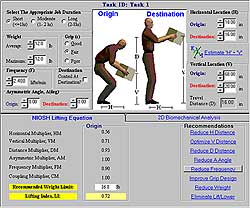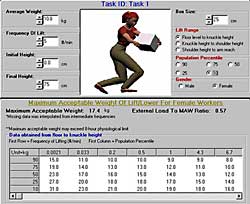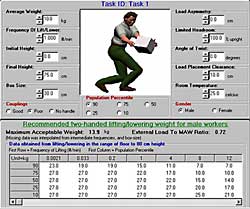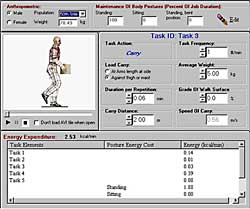ErgoIntelligence™ Manual Materials Handling (MMH)
The ErgoIntelligence™ MMH (Manual Material Handling) modules focus on material handling applications and provide an in-depth risk analysis for low-back injury using the NIOSH Lifting Equation, Biomechanics, Energy Expenditure, Mital Tables and Snook & Ciriello Tables. All modules include extensive Help and can be purchased individually.
MMH Modules include:
EI-MMH-N : NIOSH Lifting Equation with multi-task analysis
EI-MMH-NPRO : MMH-N with 2D biomechanics and 2D manikin facility
EI-MMH-SCM : Snook & Ciriello and Mital Table analysis
EI-MMH-SCMPRO : MMH-SCM with biomechanics
EI-MMH-EE : Energy Expenditure
After assessing a manual material handling task (i.e. lifting, lowering, pulling, pushing, carrying), the programs also indicate numerous generic recommendations to prevent risk of work-related Low Back Injury.
NIOSH Lifting Equation Module
There are two versions for the NIOSH Lifting Equation module (both incorporating Single and Multi-Task), with the PRO version including biomechanics and a manikin stick figure that can be manipulated.
The computed equation can provide health and safety practitioners with an empirical weight limit for manual lifting/lowering. This weight limit is referred by NIOSH as the Recommended Weight Limit (RWL). In addition to calculating the RWL for a single task, the NIOSH Lifting Equation module(s) also perform Multi-task analyses. The addition of this feature allows a comprehensive risk analysis of lifting and lowering tasks.
Snook & Ciriello / Mital Tables Module
There are two versions of the Snook & Ciriello / Mital Tables module. The PRO version includes Biomechanical Analysis and calculates the joint moment, and compression forces and shear forces at the L5/S1 disc.
The Snook & Ciriello tables can be used for the evaluation and design of manual handling (lifting, lowering, pushing, pulling and carrying) tasks. The data in these tables was obtained through extensive research from 11 studies over the past 30 years.
The tables are gender specific, and consist of a variety of population percentiles (i.e. 90th, 75th, 50th, 25th, and 10th percentile). Depending on the value from the tables, it indicates specific gender and working population work capabilities and limitations. It should be noted that the tables provide guidelines to assist industry in the control of low back pain through reductions in initial episodes, length of disability, and recurrences. Studies have found that rate of injury, severity and cost of injury is related to the population percentile capable of performing the task. More specifically, the results show that the higher the percentile population accommodated, the lower the incidence, cost, and severity of injury.
Mital tables utilize the same population and database used in the Snook tables. However the values are adjusted for various biomechanical, physiological, and epidemiological criteria. In addition, the data is also adjusted for factors that are commonly found to be significantly affecting the maximum acceptable weight of industrial workers.
The Mital tables can be used for the evaluation and design of manual handling (lifting, lowering, pushing, pulling and carrying) tasks. The Tables can also be used for one-handed horizontal lifting, one-handed carrying, holding, and material handling in unusual postures.
Mital tables account for seven factors that are found to significantly affect maximum acceptable weight of industrial workers. These factors are:
- Working duration;
- Limited headroom (spatial restraint);
- Asymmetrical lifting;
- Load asymmetry;
- Couplings (grip characteristic);
- Load placement clearance; and
- Heat stress.
To account for these seven factors, multipliers are used to adjust the maximum acceptable weight value.
A Job Severity Function is also included. The Job Severity Index (JSI) is based upon the ratio of the required weight of the lift to worker capacity. A JSI is a measure of the Musculoskeletal strain based on weight handled, frequency of lifting, and a worker's physical capacity of lifting.
Energy Expenditure Module
The Energy Expenditure module is a mathematical model (validated by various researchers) for the indirect estimation of energy expenditure. The model can be used to assess whole body fatigue, identify a specific task producing excessive fatigue, or it can be used to determine work-rest ratios.
The Energy Expenditure module can estimate metabolic rates for a specific individual or a specific gender population percentile body weight while performing a job.
The Energy Expenditure module is based on the assumption that a job can be divided into simple tasks and that the average metabolic energy rate of the job can be predicted by knowing the energy expenditure of the simple tasks and the time duration of the job. The Energy Expenditure module can be applied to stoop, squat, and arm lifts.
Download ErgoIntelligence MMH 30-Day Trial Version
ErgoIntelligence runs on Windows XP, Vista, Windows 7, 8 and 10.
Click here to request an ErgoIntelligence MMH 30-day trial.
NOTE: Software trials are provided for evaluation only prior to possible purchase by those involved in the evaluation and decision process. We also provide them to students when the university has purchased the software and the trial is coordinated thru academic staff.






